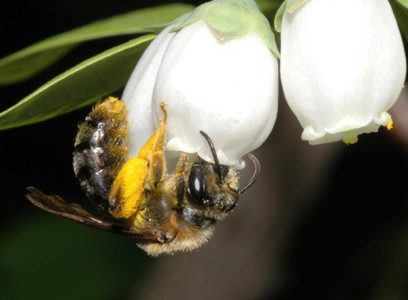

Jan 31, 2011Growers worry about the availability of bees
From Florida to the Pacific Northwest, fruit growers concerned about the threats to honeybee colonies are starting to look to native pollinators for reinforcements.
“It was the risk of not having pollinators that is the reason we started our projects,” said Alto Straughn, Florida’s largest blueberry grower.
Straughn isn’t the only one with that fear. In Oregon, cherry grower Mike Omeg has seen populations of feral honeybees plummet in the past 10 years.
“In some of our smaller orchards the ferals used to do the job, but that’s changed,” said Omeg, who now spends almost $50,000 per year to rent hives.
Growers who want to reduce the risk of poor pollination should think in terms of Integrated Crop Pollination (ICP), according to Rufus Isaacs, berry crops entomologist at Michigan State University.
“Just as growers think about IPM for pest management, we need to think about pollination in terms of multiple tactics to get the job done,” Isaacs said. “The more you can diversify your pollinators, the more reliable you’re making it for the grower.”
There is a huge diversity of native bees that will pollinate fruit crops, and for each crop there are about 10 key species – usually a mix of solitary ground-nesting bees, stem or cavity bees and social species like bumblebees.
“Adding tactics to support native bees would help, especially in those springs when it’s really cold and not good weather conditions for honey bees,” Isaacs said. “Farms with plenty of native bees should have better pollination and more consistent yield.”
Those are also the years when a smaller total crop means high prices for growers who can get flowers pollinated.
“This has been demonstrated really well with cherries in Utah,” he said.
The base recipe for encouraging native pollinators isn’t complex: Provide nesting places, provide other plants for food before and after fruit pollination, use minimal or shallow tillage and restrict the use of bee-toxic pesticides.
“It can be as simple as not mowing all your ditches every year,” Isaacs said. “Most farms have land that’s not suitable for growing fruit. Think about allowing woody plants like redbud and willow that bloom early, and a mix of summer-blooming wildflowers to grow there.”
“You don’t have to do all this at one go. You can start small, get some benefit and build on whatever works on your farm.”
While native bees will respond even to minor habitat improvements, maximizing their effectiveness calls for some study. Fruit production differs so widely – by crop, growing season and environment – the specific challenges to a bee-friendly program also differ.
In Florida, “we’ve got more native bees but we want all the native pollinators we can get,” sais Straughn, who is working with the University of Florida and the Xerces Society to improve pollination very early in the growing season.
For Mike Omeg in Oregon, the challenge is establishing flowers that will support his bees throughout the growing season.
“There are mountains of lists of plants, but they don’t tell you where to get seed or how to plant it,” Omeg said. “My focus is to narrow the lists down to about a dozen plants that are commercially available at a reasonable price, that will compete well with weeds but not become weeds, that don’t take much management once they are established and that will provide a long season of blooms for our pollinators.
“We want species that bloom in a sequence from just before the cherries bloom until the fall.”
Omeg is planting un-farmable areas within his 400 acres as insectaries – habitats that encourage beneficial insects, including bees.
“I’m really getting two birds with one stone,” he said. “My observation is that I’m increasing my yields, and I also know I’m decreasing the incidence of certain pests like black cherry aphid.”
He suggested that any grower interested in promoting native bees begin by contacting the Xerces Society, followed by a visit to the local Natural Resources Conservation Service office, which has grant money available to help farmers institute pollinator programs.
“There’s a lot of good publications now that are making the job easier,” Omeg said.
One handy source is an interactive map at www.xerces.org/pollinator-resource-center, where growers can click on any state to find region-specific native bee, plant and pesticide guides.
Extensive online information is also available at the Native Pollinators in Agriculture Work Group (www.agpollinators.org), the Xerces Society (www.xerces.org/Pollinator), the Pollinator Partnership (www.pollinator.org) or in USDA publications at (www.nrcs.usda.gov/technical/ECS/database/technotes.html
– By Edith Munro, FGN Correspondent














